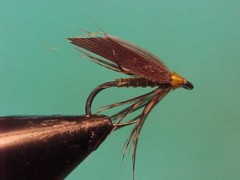Almost every English dry fly has a wee wet version. This is mine Greenwells Glory wee wet. Its a great little fly for across and down and works particularly well when fished along with a bead head spider.
 > > |
Materials
| Hook |
Thread |
Rib |
Body |
Hackle |
Wing |
| Tiemco #12 and Knapek L #14 $ #16 |
6/0 primrose yellow |
Fine silver wire |
Thread |
Most recipes call for a coch-y-bonddu hackle but I prefer an English partridge feather |
Wood duck feather slip |
Process
| A |
- Wind the thread in touching turns to the bend of the hook and then back to the 95% position.
[member Link=”p=10018″ Title=”Understanding hooks”]
- Tie in a length of fine silver wire along the top of the hook shank.
- Wind the thread back to the 95% position in tight touching turns creating a thin cigar shaped body.
- Wind the fine silver wire up the body forming 5 or 6 equal body segments.
[member Link=”p=2656″ Title=”Body segments on flies”]
- Take an extra turn of the wire in front of the body and worry off the excess wire.
|
 |
| B |
- Select an English partridge feather that has barbules about as long as the hook shank.
- Tie the feather in by the tip at the 95% position.
|
 |
| C |
- Trim away the tip of the hackle with a blade.
- Take 2 or 3 turns of hackle at the 95% position. I generally find that 2 turns is enough.
[member Link=”p=1738″ Title=”Legs on flies”]
- For all intentions at this stage, except for finishing the head of the fly, you have the equivalent of a ‘North Country’ spider.
|
 |
| D |
- Select a pair of matching feather slips.
- Tie them in just behind the eye of the hook with one each side of the fly.
- Build up a neat head of thread.
[member Link=”p=2838″ Title=”Neat thread heads”]
- Whip finish the head of the fly.
- Trim the thread and varnish the head of the fly.
|
 |
 >
>


